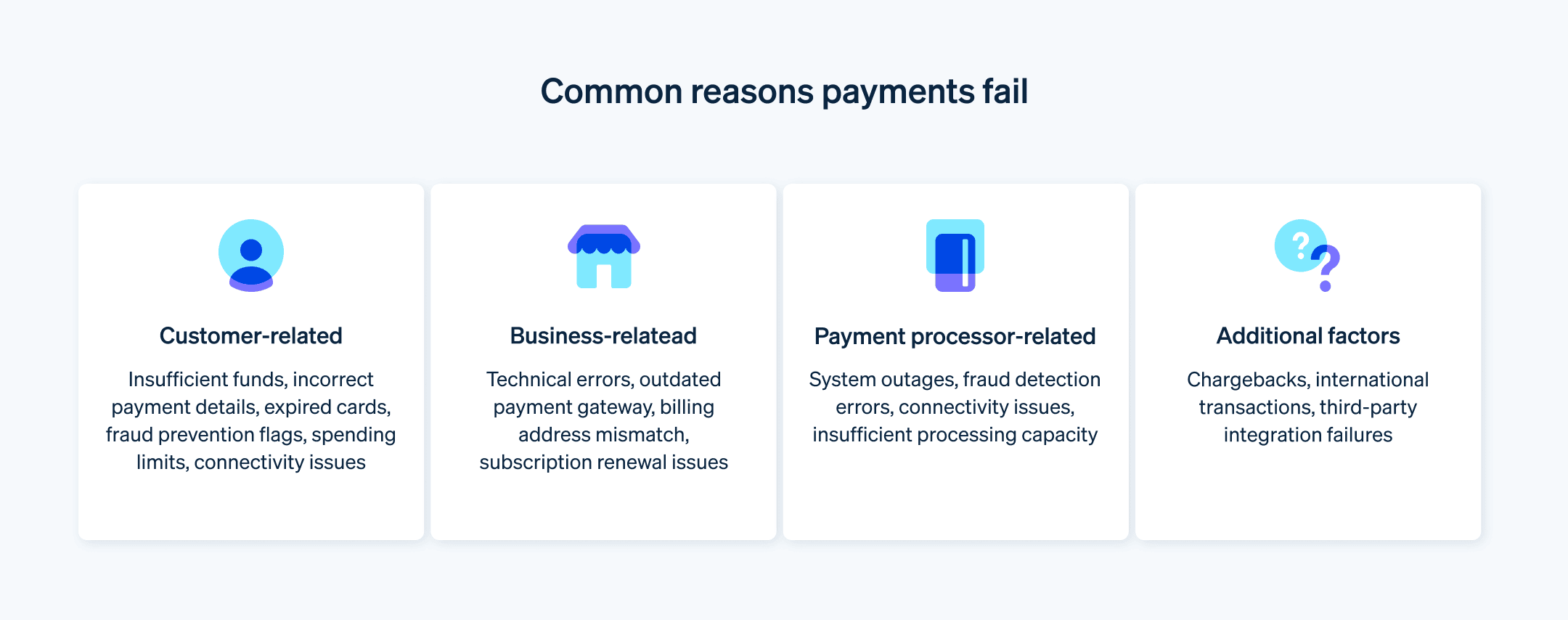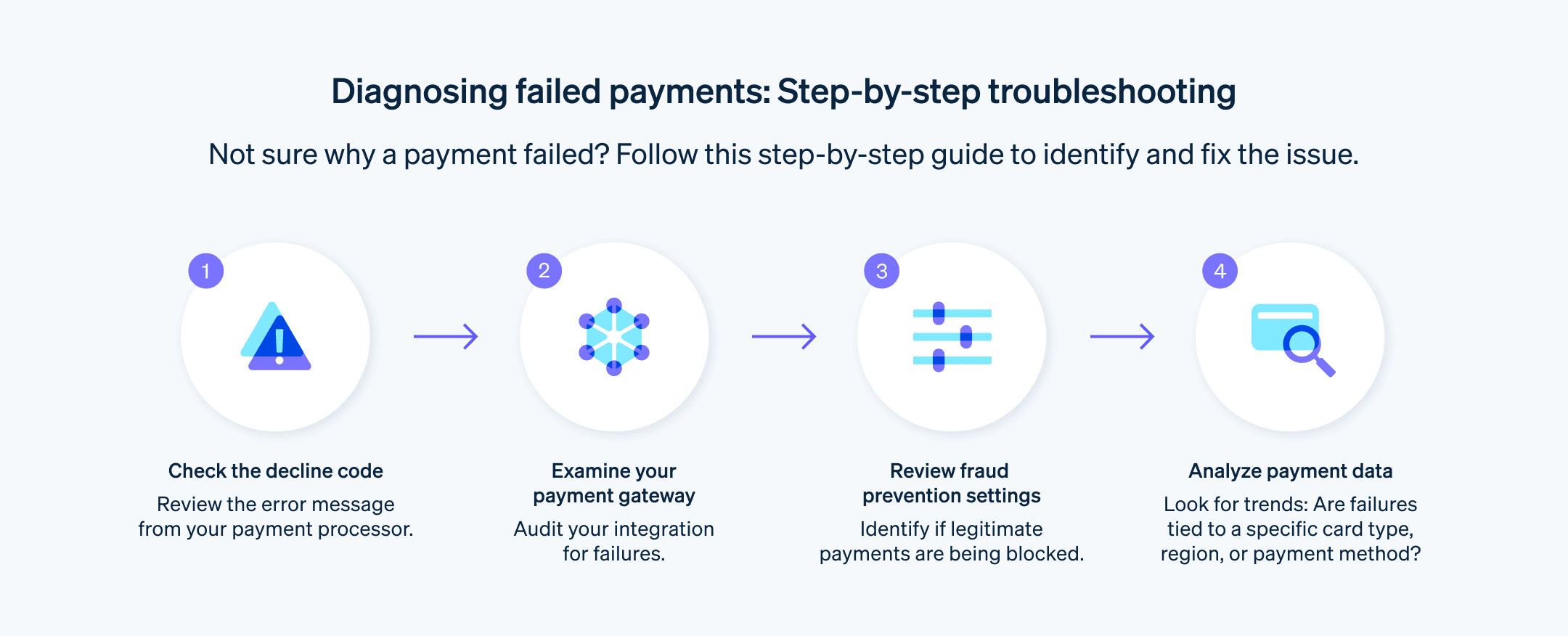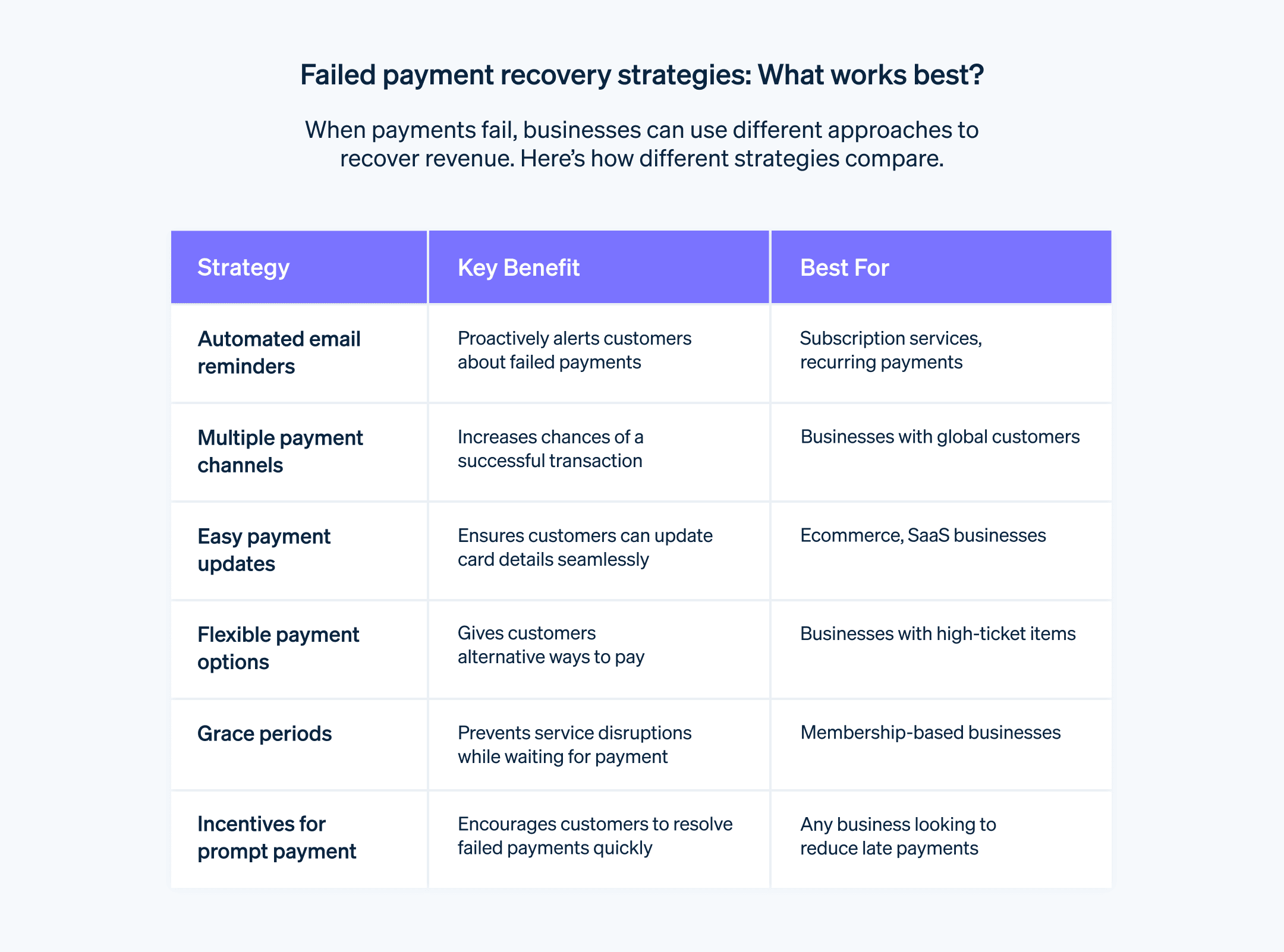在某种程度上,付款失败是大多数企业必须面对的头疼问题,但付款失败也会破坏企业在获取和留住客户方面取得的成果。一项研究发现,在 2020 年,失败的付款使全球经济损失了超过 1180 亿美元 的损失,这揭示了这部分业务的成本有多高。
下面,我们将看看付款失败的原因,并解释企业可以采取哪些步骤来找出其系统中付款失败的原因。
目录
- 付款失败的常见原因
- 如何确定企业付款失败的原因
- 如何追讨失败的付款:可使用的策略
- 追讨失败的付款的法律考虑
- Stripe 能提供什么帮助
付款失败的常见原因
支付流程、银行卡存储实践和计费操作可能因企业而异。因此,导致付款失败的原因可能有多种。以下是一些最常见的问题:
客户相关
资金不足:这通常是付款失败的主要原因。客户在尝试交易之前可能会忘记检查他们的账户余额,或者他们可能已经超出了他们的信用额度。
付款信息不正确:卡号、银行卡验证码 (CVV) 代码、到期日期或账单地址很容易导致付款失败。
过期的银行卡:客户可能没有意识到他们的银行卡已过期,或者他们可能没有向企业更新他们的付款信息。
欺诈预防:银行和支付处理商经常使用欺诈检测算法来标记可疑活动。这可能会导致合法交易被拒绝,尤其是在客户进行大额或不寻常的购买时。
信用额度不足:对于信用卡交易,客户的可用信用额度可能不足以支付购买费用。
账户限制:一些银行和支付处理商可能会设置每日或每周的支出限额,以防止欺诈。这些限制还可能导致付款被拒绝。
技术问题:客户可能会遇到互联网连接问题或设备问题,导致他们无法完成付款流程。
业务相关
技术错误:商家网站或支付处理商 可能导致交易失败。
支付网关配置不正确:如果商家的支付网关 设置不正确,可能无法正确处理付款。
过时的软件:企业网站或服务器上的过时软件可能会导致付款失败。
货币错配:如果客户的结算币种与企业接受的币种不同,交易可能会被拒绝。
安全问题:企业可能采取了安全措施来阻止某些类型的交易被处理,即使它们是合法的。
续订问题:经常性付款 可能会因客户的付款信息变更、资金不足或银行卡过期而失败。
账单地址不匹配:如果客户账户上的账单地址与其支付方式上的地址不符,交易可能会被拒绝。
支付处理商相关
系统中断:支付处理商可能会遇到中断,从而阻止交易的处理。
欺诈检测错误:与银行非常相似,支付处理商可能会使用欺诈检测算法,这些算法可能会错误地拒绝合法交易。
处理能力不足:在购物高峰期,支付处理商可能会遇到大量交易,这可能导致延迟和失败。
连接问题:支付处理商的网络问题可能导致交易失败。
其他因素

如何确定企业付款失败的原因
采取措施预防和应对失败的付款很重要,但要正确解决这些问题,首先要了解您的企业发生失败付款的原因。以下是帮助您找出付款失败的根本原因的分步流程:
检查拒绝代码:在个人层面上,确定导致付款失败的原因的第一步是检查支付处理商提供的拒绝代码。银行卡拒绝代码 通常是一个两位数的字母数字错误代码,用于解释银行卡交易被拒绝的原因。
检查您的支付网关:如果您正在调查多笔失败的付款,查看您的支付网关通常可以提供答案。对网关集成进行彻底审计,以编译有关哪些类型的交易失败的数据。问题可能会很快显现出来,但如果没有,请尽可能多地收集信息。
查看欺诈预防设置:由于欺诈检测和预防工具有时会标记合法付款,因此请检查每个设置,以确定是否有任何设置过于严格,或者可能错误地将付款标记为可疑。
分析支付数据:仔细查看您从支付网关和防欺诈软件中收集的数据,以确定是否存在任何影响您企业付款的因素。它可能是某种支付方式、来自特定地区的交易或一天中特定时间的付款更有可能失败。如果出现一种模式,那很可能就是答案。

如何进行支付失败后的款项追回:可使用的策略
自动电子邮件提醒
主动及时干预:失败的付款很容易被遗忘,尤其是在处理定期订阅或月度账单时。自动电子邮件提醒可作为主动提示,提醒客户未付款项。这种及时干预能够提高追回支付款项成功的几率,并降低账户流失的风险。
个性化沟通:与其发送通用提醒,不如使用邮件个性化来创造更具吸引力和相关性的体验。称呼客户的姓名,提及具体金额和发票明细,并提供多种支付方式,以方便客户使用。个性化沟通可以培养积极的客户体验,并增加及时付款的可能性。
自动化工作流程效率:手动管理失败的付款既费时又低效。自动电子邮件提醒可自动执行该过程,从而为其他任务腾出宝贵的资源。这样,您就可以在不影响付款追讨工作的情况下扩展业务。
自定义日程安排:根据付款失败的具体情况,有策略地发送提醒信息。例如,考虑在尝试失败后 24 小时内发送第一封提醒邮件,然后每隔一段时间发送逐渐强硬的提醒邮件。这种策略确保及时跟进而不使客户感到压力。
多渠道方法:将邮件提醒与其他沟通渠道结合以达到最大效果。考虑向移动应用用户发送短信提醒或推送通知,以增加覆盖范围和响应性。
数据驱动优化:跟踪电子邮件提醒的效果,并分析关键指标,例如打开率、点击率和转化率。使用这些数据来优化邮件内容、主题行、时间和频率以达到最佳效果。
与支付网关集成:许多支付网关具有自动邮件提醒的内置功能。使用这些集成来简化您的工作流程并简化支付失败管理。
对不同的策略进行 A/B 测试:尝试不同的邮件内容、主题行和发送时间,看看哪些最能引起客户的共鸣。这种数据驱动的方法使您能够个性化您的提醒并最大化其效果。
使用自动化工具:使用营销自动化平台或专门的失败付款追讨软件来自动发送电子邮件提醒。通过这些工具,您可以创建定制的工作流程,与各种系统集成,并跟踪营销活动的效果。
提供付款协助:发送电子邮件提醒时,请考虑为在付款方面遇到困难的客户提供有用的资源或帮助。这可能包括提供付款常见问题解答、替代支付方式或分期付款方案。表现出同理心和帮助意愿可以大大提高客户满意度并鼓励完成付款。
多种支付渠道
多种支付方式:企业可以提供各种支付方式,例如信用卡和借记卡、银行转账、数字钱包,有时还有现金或支票选项。这种多样性使得在一种支付方式失败时,客户可以轻松切换到另一种方式。
技术集成:集成支持多种支付方式的支付网关等技术有助于使流程顺利进行。这种集成允许在支付方式之间轻松切换,而不会对客户体验造成重大干扰。
减少对单个渠道的依赖:依赖一种支付方式可能会有风险。如果该方法遇到问题,可能会导致大量付款失败。多渠道分散了这种风险。
客户偏好和无障碍性:不同的客户有不同的偏好和支付方式。例如,有些人可能更喜欢数字钱包,因为它们方便,而另一些人可能更信任传统的银行转账。为客户提供多种选择可以满足不同客户的需求。
地理因素考虑:付款偏好可能因地区而异。虽然信用卡在一个国家可能很受欢迎,但移动支付可能是另一种常态。面向国际的企业必须考虑这些地区偏好。
减少交易放弃:如果支付失败,立即提供替代方法可以减少交易放弃的可能性。这在电商中尤为重要,因为客户在遇到问题时可能不会返回完成购买。
合规性和安全性:不同的支付渠道具有不同的合规性和安全标准。企业必须确保所有可用渠道都遵守必要的法规,并维护强大的安全系统,以保护客户数据和防止欺诈。
简单的付款更新选项
用户友好的界面:设计一个直观且易于使用的界面,客户可以在其中更新他们的支付信息,这很重要。这可以是移动应用或门户网站的一部分,也可以通过客户服务渠道实现。
过期自动提醒:实施自动提醒,在客户的支付信息过期前提醒他们,有助于主动更新详细信息。这降低了由于信息过时而导致交易失败的风险。
多种更新渠道:提供各种更新支付信息的渠道(例如通过应用、网站或客户支持或电子邮件链接),确保所有客户群都能使用。
安全和隐私:验证付款更新过程是否安全并符合数据保护法规非常重要。客户需要相信他们的财务信息得到安全处理。
支付方式的灵活性:在更新过程中,让客户在支付方式之间切换(例如从信用卡到直接银行转账)可以满足不断变化的客户偏好或情况。
实时更新能力:系统应该能够实时或尽可能接近实时地处理更新,以避免可能导致进一步付款失败的延迟。
清晰的沟通和指导:提供更新支付信息的便捷说明和帮助有助于减少更新过程中的混乱和错误。
与客户档案集成:将支付更新系统与客户资料关联起来,可实现更个性化的策略,而且由于系统已掌握相关的客户信息,更新也会更容易。
失败交易的反馈循环:交易失败后,立即引导客户更新支付信息可增加成功追讨付款的机会。
更新后自动重试:一旦支付信息更新,自动重试失败交易可以帮助立即恢复,而无需客户采取额外行动。
灵活的支付方式
多样化的支付方式:为客户提供多种支付方式,包括信用卡和借记卡、银行转账、数字钱包和本地支付选项。这种多样性迎合了客户的不同偏好,并增加了成功交易的可能性。
简便的支付方式更新:让客户轻松更新他们的付款详情。这可以通过网站或应用上的用户友好界面来完成。为客户提供易于遵循的说明和随时可用的帮助可以鼓励及时更新,减少因信息过时而导致的付款失败。
自动重试逻辑:为失败的交易实现自动重试逻辑。这涉及在不同的时间或日期重试交易,考虑到资金不足或银行停机等临时问题可能会导致失败。
灵活的付款安排:允许客户选择或更改付款日期。这种灵活性可以将付款日期与他们的财务周期(例如工资存款)联系起来,从而提高付款的成功率。
付款方案:为面临暂时财务困难的客户提供付款方案。这可能包括延长付款期限或将付款分解为更小、更易于管理的金额。
实时通知:发送失败交易的即时通知。这样可以让客户了解情况并提示他们采取必要的措施,例如更新支付信息或验证是否有足够资金可用。
客户支持:为支付相关问题提供专门的客户支持。训练有素的支持人员可以协助客户解决付款失败问题、寻找替代支付方式或制定付款方案。
数据分析和洞察:定期分析付款数据,以识别付款失败的趋势和问题。获得的见解可以指导支付流程和策略的改进。
安全与合规:确保所有支付方式和流程安全,并符合相关法规,例如针对银行卡支付的支付卡行业数据安全标准 (PCI DSS)。这样可以防止欺诈并建立客户信任。
用户教育:让用户知晓可用的支付选项和交易最佳实践。这可以包括常见问题解答、教程或通过客户支持进行直接沟通。
轻松集成:将灵活的支付选项集成到客户体验中。该过程应该是直观的,并且不会在用户进行交易时中断用户。
基于客户细分的定制:根据客户细分定制支付选项。不同的细分市场可能有不同的偏好和财务行为,这可以为每个群体提供最合适的支付解决方案。
宽限期
宽限期是指允许客户解决付款问题的指定时间,在此期间,客户不会立即面临罚款或服务中断。有效实施宽限期需要了解客户需求、法规要求以及对企业运营的影响。以下是一些最佳实践:
明确告知宽限期条款:告知宽限期的长度及其适用条件。这些条款的透明度有助于管理客户期望并减少混淆。
合理的持续时间:给客户一个纠正付款问题的公平机会,但又不能太长,以免明显影响你的收入。宽限期可根据行业标准和服务或产品而有所不同。
自动通知:在宽限期之前和期间向客户发送自动提醒。这些提醒应包括付款到期日、宽限期的结束日期以及不付款的任何潜在后果。
灵活的延期选项:考虑在某些情况下提供延长宽限期的选项,特别是对于付款记录良好的客户或面临暂时经济困难的客户。
及时付款的激励措施
以下是一些实施及时付款激励措施的最佳做法:
有吸引力的激励方案:提供真正吸引客户群的激励措施。常见的激励措施包括未来购买的折扣、忠诚度积分、现金返还或享受独家服务或产品。
明确告知条款:确保以易于理解的方式向客户传达激励计划的条款和条件。这包括资格标准、奖励的授予方式和时间,以及任何限制或到期日期。
简单的兑换流程:任何激励措施的兑换流程都要简便易行。复杂的兑换流程会降低激励措施的价值。
定期推广:通过电子邮件和应用内通知等各种渠道以及在结账过程中积极推广奖励计划。定期促销使该计划成为客户的首要考虑因素。
与业务目标保持一致:在设计激励计划时,要与更广泛的业务目标相一致。例如,如果增加重复购买是一个目标,那么就可以考虑鼓励消费的激励措施。
分段方法:根据客户的购买行为、偏好和付款记录,为不同的客户群量身定制激励措施。这种有针对性的策略可以提高激励措施的有效性。
监测和评估:持续监控激励计划的绩效。评估其对支付行为的影响,并根据数据驱动的见解进行调整。
合规和道德方面的考虑:确保激励计划符合相关法律法规,尤其是与金融交易和营销相关的法律法规。考虑激励计划的道德影响也很重要,以避免鼓励不负责任的财务行为。
反馈机制:实施一个系统来收集客户对激励计划的反馈。这些反馈意见可以帮助我们深入了解客户对计划的看法以及如何改进计划。
可扩展且灵活的设计:将程序设计为可扩展且灵活,允许根据不断变化的市场条件、客户行为和业务需求进行调整。
技术集成:使用技术自动跟踪和授予奖励。这可能包括与支付系统、客户关系管理 (CRM) 解决方案和营销工具的集成。
成本效益分析:定期对激励计划进行成本效益分析,以确保其在财务上是可持续的,并提供所需的投资回报。
变更的透明度:如果项目发生变化,应及时向客户通报调整情况,以保持信任和项目的完整性。
教育性内容:提供教育内容,帮助客户了解激励的价值以及他们如何从参与计划中受益。

追讨失败的付款的法律考虑
付款失败的问题与法律和合规考虑事项 有关,所有企业在处理客户付款时都必须注意这些事项。以下是这些交叉点的详细介绍:
了解当地和国际法律:企业必须了解其经营所在司法管辖区管理债务催收和付款处理的法律框架。这包括对当地法律和国际法规的了解,尤其是在跨境经营时。
遵守收债惯例:遵守公平的收债惯例很重要。这包括了解追究未偿债务的法律和道德行为,例如限制联系客户和禁止骚扰。
数据保护和隐私:证明遵守数据保护法律(例如欧盟的《一般数据保护条例》(GDPR) 或《加州消费者隐私法案》(CCPA))是维持运营的关键。这包括在付款追讨过程中如何使用和存储客户数据。
明确的条款和条件:企业应核实其有关付款和潜在追偿行动的条款和条件是否易于获取并得到客户认可。这种明确性可以防止因对付款义务的误解而产生法律纠纷。
保存记录和文件:准确记录与客户的所有沟通和交易非常重要。这些文件在法律诉讼或追讨付款的争议中尤为重要。
了解破产法和无力偿债法:熟悉破产和无力偿债法律是关键,因为客户有可能宣布破产。了解这些法律对债务追收流程的影响有助于为企业提供指导。
员工培训和政策:为参与追回付款的员工提供法律要求和道德实践方面的培训,可以提高合规性,降低不当行为引发法律问题的风险。
与第三方机构签订的合同:如果使用第三方机构进行债务催收,企业必须确保这些机构也遵守所有相关法律法规。与这些机构签订的合同应明确说明这些要求。
利息和费用:对逾期付款收取的任何利息或费用都必须符合法律限制,并事先明确告知客户。过高的收费可能导致法律质疑和声誉受损。
争议解决机制:为对债务有效性或追讨过程提出质疑的客户实施公平的争议解决机制非常重要。这有助于在不诉诸法律的情况下解决问题。
消费者保护法:消费者保护法旨在保护客户免受不公平商业行为的侵害,企业应确保遵守这些法律。这包括诚实的产品广告和透明的计费方式。
无障碍和非歧视:确保付款追讨流程的无障碍性和非歧视性非常重要。这意味着要考虑所有客户的需求,包括残疾客户或使用不同语言的客户。
恢复策略的法律审查:定期对付款追讨战略和策略进行法律审查,有助于验证合规性并适应法律的任何变化。
与法律顾问的沟通:与法律顾问保持开放的沟通渠道有助于快速解决出现的任何法律问题,并确保恢复策略保持合规。
Stripe 能提供什么帮助
Stripe 的支付解决方案包括多项功能,助力企业预防和应对失败的付款,包括:
防止付款失败
Radar:Stripe 的防欺诈工具 Radar 基于机器学习,可在可疑交易发生前识别并阻止其发生,从而大大降低欺诈和支付失败的风险。
付款意向:此功能 允许企业预先收集所有必要的支付信息并确保授权,防止在付款时出现资金不足或卡过期等问题。
强客户认证 (SCA):Stripe 支持 SCA,这是一种安全标准,有助于验证持卡人的身份,并进一步减少欺诈和付款失败。
动态 3DS 验证 (3DS):这种先进的 3DS 实施提供了安全的支付体验,同时进一步改善了欺诈保护。
可定制的拒绝代码:企业可以定义自己的拒绝代码,以接收有关付款失败的更具体信息,从而确定并解决根本原因。
响应失败的付款
自动重试:Stripe 可以使用不同的支付方式或在指定期限后自动重试失败的付款,从而增加收款的机会。
Payment Links:企业可以轻松创建和分享 Payment Links,以方便客户重试付款。
催款电子邮件:Stripe 提供可定制的催款,这些电子邮件可自动发送给未付款的客户,提醒他们付款并提供便捷的付款方式。
付款追讨服务:Stripe 与各种付款追讨企业合作,提供包括债务追讨和退款协助在内的附加服务。
详细洞见:Stripe 提供全面的仪表板和报告,提供有关支付趋势、拒付率和其他关键指标的宝贵见解,帮助企业确定需要改进的领域。
额外福利
全球触及:Stripe 支持超过 135 种货币的支付,使企业能够接触到全球客户,并最大限度地降低因货币兼容性问题而导致支付失败的风险。
可扩展性:Stripe 的技术旨在处理大量交易,确保企业即使在增长的同时也能有效地处理付款。
安全性:Stripe 遵守最高的安全标准和法规,保护企业和客户免受欺诈和数据泄露的侵害。
本文中的内容仅供一般信息和教育目的,不应被解释为法律或税务建议。Stripe 不保证或担保文章中信息的准确性、完整性、充分性或时效性。您应该寻求在您的司法管辖区获得执业许可的合格律师或会计师的建议,以就您的特定情况提供建议。